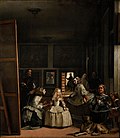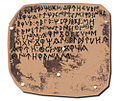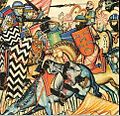Portal:Spain
Portal maintenance status: (June 2018)
|
The Spain Portal (Bienvenido al portal español)

Spain, also the Kingdom of Spain, is a country in Southern and Western Europe with territories in North Africa. Featuring the southernmost point of continental Europe, it is the largest country in Southern Europe and the fourth-most populous European Union member state. Spanning across the majority of the Iberian Peninsula, its territory also includes the Canary Islands, in the Eastern Atlantic Ocean, the Balearic Islands, in the Western Mediterranean Sea, and the autonomous cities of Ceuta and Melilla, in mainland Africa. Peninsular Spain is bordered to the north by France, Andorra, and the Bay of Biscay; to the east and south by the Mediterranean Sea and Gibraltar; and to the west by Portugal and the Atlantic Ocean. Spain's capital and largest city is Madrid, and other major urban areas include Barcelona, Valencia, Seville, Zaragoza, Málaga, Murcia, and Palma de Mallorca.
In early antiquity, the Iberian Peninsula was inhabited by Celts, Iberians, and other pre-Roman peoples. With the Roman conquest of the Iberian peninsula, the province of Hispania was established. Following the Romanisation and Christianisation of Hispania, the fall of the Western Roman Empire ushered in the inward migration of tribes from Central Europe, including the Visigoths, who formed the Visigothic Kingdom centred on Toledo. In the early eighth century, most of the peninsula was conquered by the Umayyad Caliphate, and during early Islamic rule, Al-Andalus became a dominant peninsular power centred on Córdoba. The several Christian kingdoms that emerged in Northern Iberia, chief among them Asturias, León, Castile, Aragon and Navarre, made an intermittent southward military expansion and repopulation, known as the Reconquista, repelling Islamic rule in Iberia, which culminated with the Christian seizure of the Nasrid Kingdom of Granada in 1492. The dynastic union of the Crown of Castile and the Crown of Aragon in 1479 under the Catholic Monarchs is often considered the de facto unification of Spain as a nation state. (Full article...)
 Featured article – show another
Featured article – show another
-
Image 1Lombardy in 1522. The location of the battle is marked.
The Battle of Bicocca or La Bicocca (Italian: Battaglia della Bicocca) was fought on 27 April 1522, during the Italian War of 1521–26. A combined French and Venetian force under Odet de Foix, Vicomte de Lautrec, was decisively defeated by an Imperial–Spanish and Papal army under the overall command of Prospero Colonna. Lautrec then withdrew from Lombardy, leaving the Duchy of Milan in Imperial hands. (Full article...) -
Image 2Battle of Chiclana, 5 March 1811, Louis-François Lejeune
The Battle of Barrosa (Chiclana, 5 March 1811, also known as the Battle of Chiclana or Battle of Cerro del Puerco) was part of an unsuccessful manoeuvre by an Anglo-Iberian force to break the French siege of Cádiz during the Peninsular War. During the battle, a single British division defeated two French divisions and captured a regimental eagle. (Full article...) -
Image 3
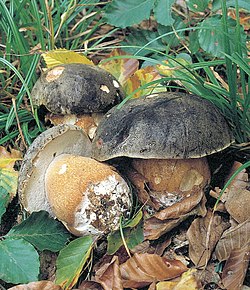
Boletus aereus, commonly known as the dark cep, bronze bolete, or queen bolete, is a highly prized and much sought-after edible mushroom in the family Boletaceae. The bolete is widely consumed in Spain (Basque Country and Navarre), France, Italy, Greece, and generally throughout the Mediterranean. Described in 1789 by French mycologist Pierre Bulliard, it is closely related to several other European boletes, including B. reticulatus, B. pinophilus, and the popular B. edulis. Some populations in North Africa have in the past been classified as a separate species, B. mamorensis, but have been shown to be phylogenetically conspecific to B. aereus and this taxon is now regarded as a synonym. (Full article...) -
Image 4View of Badajoz, across the Guadiana river from the foothills of the San Cristóbal heights, by Eugène-Ferdinand Buttura
The Battle of the Gebora took place during the Peninsular War between Spanish and French armies on 19 February 1811, northwest of Badajoz, Spain. An outnumbered French force routed and nearly destroyed the Spanish Army of Extremadura. (Full article...) -
Image 5

Joseph Anton Lopez SJ (born José Antonio López; October 4, 1779 – October 5, 1841) was a Mexican Catholic priest and Jesuit. Born in Michoacán, he studied canon law at the Colegio de San Nicolás and the Royal and Pontifical University of Mexico. He became acquainted with the future Empress consort Ana María Huarte and was made chaplain to the future imperial family. He was later put in charge of the education of all the princes in Mexico. Lopez was a close ally of Emperor Agustín de Iturbide, residing in Madrid for four years as his attorney and political informant, and accompanying him during his exile to Italy and England. (Full article...) -
Image 6

Rokeby Venus, c. 1647–1651. 122 cm × 177 cm (48 in × 70 in). National Gallery, London.
The Rokeby Venus (/ˈroʊkbi/ ROHK-bee; also known as The Toilet of Venus, Venus at her Mirror, Venus and Cupid and, in Spanish, La Venus del espejo) is a painting by Diego Velázquez, the leading artist of the Spanish Golden Age. Completed between 1647 and 1651, and probably painted during the artist's visit to Italy, the work depicts the goddess Venus in a sensual pose, lying on a bed with her back facing the viewer, and looking into a mirror held by the Roman god of physical love, her son Cupid. The painting is in the National Gallery, London. (Full article...) -
Image 7The Lince (Spanish pronunciation: [ˈlinθe], meaning "Lynx") was a Spanish development programme for a proposed main battle tank that unfolded during the late 1980s and early 1990s. The intention was to replace the M47 and M48 Patton tanks that the Spanish Army had received under the U.S. Mutual Defense Assistance Act between 1954 and 1975, and to complement the AMX-30E tanks manufactured for the army during the 1970s. Companies from several nations, such as German Krauss-Maffei, Spanish Santa Bárbara, and French GIAT, made bids for the development contract. The main priorities were mobility and firepower, with secondary priority placed on protection; the Lince tank was to have been lighter and faster than its competitors. To achieve a sufficient level of firepower and protection, the Lince was to use Rheinmetall's 120 mm L/44 tank-gun and German composite armour from the Leopard 2A4. (Full article...)
-
Image 8

The Third of May 1808 in Madrid (commonly known as The Third of May 1808) and also known, in Spanish, as El tres de mayo de 1808 en Madrid or Los fusilamientos de la montaña del Príncipe Pío, or Los fusilamientos del tres de mayo, is a painting completed in 1814 by the Spanish painter Francisco Goya, now in the Museo del Prado, Madrid. In the work, Goya sought to commemorate Spanish resistance to Napoleon's armies during the occupation of Madrid in 1808 at the start of the Peninsular War. Along with its companion piece of the same size, The Second of May 1808 (or The Charge of the Mamelukes), it was commissioned by the provisional government of Spain at Goya's own suggestion shortly after the ousting of the French occupation and the restoration of King Ferdinand VII. (Full article...) -
Image 9
The Spanish conquest of Petén was the last stage of the conquest of Guatemala, a prolonged conflict during the Spanish colonisation of the Americas. A wide lowland plain covered with dense rainforest, Petén contains a central drainage basin with a series of lakes and areas of savannah. It is crossed by several ranges of low karstic hills and rises to the south as it nears the Guatemalan Highlands. The conquest of Petén, a region now incorporated into the modern republic of Guatemala, climaxed in 1697 with the capture of Nojpetén, the island capital of the Itza kingdom, by Martín de Ursúa y Arizmendi. With the defeat of the Itza, the last independent and unconquered native kingdom in the Americas fell to European colonisers. (Full article...) -
Image 10The ruins of Santa María de Óvila in Spain, shown more than 75 years after the most striking architectural features were removed by agents of William Randolph Hearst
Santa María de Óvila is a former Cistercian monastery built in Spain beginning in 1181 on the Tagus River near Trillo, Guadalajara, about 90 miles (140 km) northeast of Madrid. In 1835 it was confiscated by the Spanish government and sold to private owners. (Full article...) -
Image 11

An M48 Patton tank of the Spanish Army on display at the El Goloso Museum of Armored Vehicles in October 2007.
Tanks in the Spanish Army have over 90 years of history, from the French Renault FTs first delivered in 1919 to the Leopard 2 and B1 Centauro models of the early 21st century. The Spanish FTs took part in combat during the Rif War and participated in the first amphibious landing with tanks in history, at Alhucemas. In 1925, the Spanish Army began to undertake a program to develop and produce a Spanish tank, an upgraded version of the Renault FT, called the Trubia A4. Although the prototype performed well during testing, the tank was never put into mass production. Spain also experimented with the Italian Fiat 3000, acquiring one tank in 1925, and with another indigenous tank program called the Landesa. However, none of these evolved into a major armor program, and as a result the FT remained the most important tank, in numbers, in the Spanish Army until the beginning of the Spanish Civil War. (Full article...) -
Image 12Muhammad II (Arabic: محمد الثاني) (also known by the epithet al-Faqih, "the canon-lawyer", c. 1235 – 8 April 1302; reigned from 1273 until his death) was the second Nasrid ruler of the Emirate of Granada in Al-Andalus on the Iberian Peninsula, succeeding his father, Muhammad I. Already experienced in matters of state when he ascended the throne, he continued his father's policy of maintaining independence in the face of Granada's larger neighbours, the Christian kingdom of Castile and the Muslim Marinid state of Morocco, as well as an internal rebellion by his family's former allies, the Banu Ashqilula. (Full article...)
-
Image 13
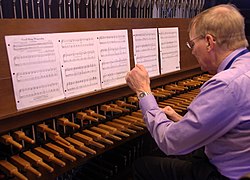
A carillonneur plays the 56-bell carillon of the Plummer Building, Rochester, Minnesota, US
A carillon is a pitched percussion instrument that is played with a keyboard and consists of at least 23 bells. The bells are cast in bronze, hung in fixed suspension, and tuned in chromatic order so that they can be sounded harmoniously together. They are struck with clappers connected to a keyboard of wooden batons played with the hands and pedals played with the feet. Often housed in bell towers, carillons are usually owned by churches, universities, or municipalities. They can include an automatic system through which the time is announced and simple tunes are played throughout the day. (Full article...) -
Image 14
Verdeja was the name of a series of light tanks developed in Spain between 1938 and 1954 in an attempt to replace German Panzer I and Soviet T-26 tanks in Spanish service. (Full article...) -
Image 15Abu Abdullah Muhammad ibn Ismail (Arabic: أبو عبد الله محمد بن إسماعيل الرابع), also known as Muhammad IV (14 April 1315 – 25 August 1333), was the ruler of the Emirate of Granada on the Iberian Peninsula from 1325 to 1333. He was the sixth Sultan of the Nasrid dynasty, succeeding to the throne at ten years old when his father, Ismail I (r. 1314–1325), was assassinated. (Full article...)
-
Image 16Muhammad I (red tunic and shield) depicted leading his troops during the Mudéjar revolt of 1264–1266 in the Cantigas de Santa Maria
Abu Abdullah Muhammad ibn Yusuf ibn Nasr (Arabic: أبو عبد الله محمد بن يوسف بن نصر, romanized: Muḥammad ibn Yūsuf ibn Naṣr; c. 1195 – 22 January 1273), also known as Ibn al-Ahmar (ابن الأحمر, lit. 'Son of the Red') and by his honorific al-Ghalib billah (الغالب بالله, lit. 'The Victor by the Grace of God'), was the first ruler of the Emirate of Granada, the last independent Muslim state on the Iberian Peninsula, and the founder of its ruling Nasrid dynasty. He lived during a time when Iberia's Christian kingdoms—especially Portugal, Castile and Aragon—were expanding at the expense of the Islamic territory in Iberia, called Al-Andalus. Muhammad ibn Yusuf took power in his native Arjona in 1232 when he rebelled against the de facto leader of Al-Andalus, Ibn Hud. During this rebellion, he was able to take control of Córdoba and Seville briefly, before he lost both cities to Ibn Hud. Forced to acknowledge Ibn Hud's suzerainty, Muhammad was able to retain Arjona and Jaén. In 1236, he betrayed Ibn Hud by helping Ferdinand III of Castile take Córdoba. In the years that followed, Muhammad was able to gain control over southern cities, including Granada (1237), Almería (1238), and Málaga (1239). In 1244, he lost Arjona to Castile. Two years later, in 1246, he agreed to surrender Jaén and accept Ferdinand's overlordship in exchange for a 20-year truce. (Full article...) -
Image 17
The AMX-30E (E stands for España, Spanish for Spain) is a Spanish main battle tank based on France's AMX-30. Although originally the Spanish government sought to procure the German Leopard 1, the AMX-30 was ultimately awarded the contract due to its lower price and the ability to manufacture it in Spain. 280 units were manufactured by Santa Bárbara Sistemas for the Spanish Army, between 1974 and 1983. (Full article...) -
Image 18Nasr (1 November 1287 – 16 November 1322), full name Abu al-Juyush Nasr ibn Muhammad (Arabic: أبو الجيوش نصر بن محمد), was the fourth Nasrid ruler of the Emirate of Granada from 14 March 1309 until his abdication on 8 February 1314. He was the son of Muhammad II al-Faqih and Shams al-Duha. He ascended the throne after his brother Muhammad III was dethroned in a palace revolution. At the time of his accession, Granada faced a three-front war against Castile, Aragon and the Marinid Sultanate, triggered by his predecessor's foreign policy. He made peace with the Marinids in September 1309, ceding to them the African port of Ceuta, which had already been captured, as well as Algeciras and Ronda in Europe. Granada lost Gibraltar to a Castilian siege in September, but successfully defended Algeciras until it was given to the Marinids, who continued its defense until the siege was abandoned in January 1310. James II of Aragon sued for peace after Granadan defenders defeated the Aragonese siege of Almería in December 1309, withdrawing his forces and leaving the Emirate's territories by January. In the ensuing treaty, Nasr agreed to pay tributes and indemnities to Ferdinand IV of Castile and yield some border towns in exchange for seven years of peace. (Full article...)
-
Image 19
The Battle of Halmyros, known by earlier scholars as the Battle of the Cephissus or Battle of Orchomenos, was fought on 15 March 1311, between the forces of the Frankish Duchy of Athens and its vassals under Walter of Brienne against the mercenaries of the Catalan Company, resulting in a decisive victory for the mercenaries. (Full article...) -
Image 20Northern Italy in 1494; by the start of the war in 1508, Louis XII had expelled the Sforza from the Duchy of Milan and added its territory to France.
The War of the League of Cambrai, sometimes known as the War of the Holy League and several other names, was fought from February 1508 to December 1516 as part of the Italian Wars of 1494–1559. The main participants of the war, who fought for its entire duration, were France, the Papal States, and the Republic of Venice; they were joined at various times by nearly every significant power in Western Europe, including Spain, the Holy Roman Empire, England, the Duchy of Milan, the Republic of Florence, the Duchy of Ferrara, and the Swiss. (Full article...) -
Image 21The siege of Nice by a Franco-Ottoman fleet in 1543 (drawing by Toselli, after an engraving by Aeneas Vico)
The Italian War of 1542–1546 was a conflict late in the Italian Wars, pitting Francis I of France and Suleiman I of the Ottoman Empire against the Holy Roman Emperor Charles V and Henry VIII of England. The course of the war saw extensive fighting in Italy, France, and the Low Countries, as well as attempted invasions of Spain and England. The conflict was inconclusive and ruinously expensive for the major participants. (Full article...) -
Image 22Conquistador Pedro de Alvarado led the initial efforts to conquer Guatemala.
In a protracted conflict during the Spanish colonization of the Americas, Spanish colonisers gradually incorporated the territory that became the modern country of Guatemala into the colonial Viceroyalty of New Spain. Before the conquest, this territory contained a number of competing Mesoamerican kingdoms, the majority of which were Maya. Many conquistadors viewed the Maya as "infidels" who needed to be forcefully converted and pacified, disregarding the achievements of their civilization. The first contact between the Maya and European explorers came in the early 16th century when a Spanish ship sailing from Panama to Santo Domingo (Hispaniola) was wrecked on the east coast of the Yucatán Peninsula in 1511. Several Spanish expeditions followed in 1517 and 1519, making landfall on various parts of the Yucatán coast. The Spanish conquest of the Maya was a prolonged affair; the Maya kingdoms resisted integration into the Spanish Empire with such tenacity that their defeat took almost two centuries. (Full article...) -
Image 23Muhammad III (Arabic: محمد الثالث; 15 August 1257 – 21 January 1314) was the ruler of the Emirate of Granada in Al-Andalus on the Iberian Peninsula from 8 April 1302 until 14 March 1309, and a member of the Nasrid dynasty. He ascended the Granadan throne after the death of his father Muhammad II, which according to rumours, was caused by Muhammad III poisoning him. He had the reputation of being both cultured and cruel. Later in his life, he became visually impaired—which caused him to be absent from many government activities and to rely on high officials, especially the powerful Vizier Ibn al-Hakim al-Rundi. (Full article...)
-
Image 24
The Second Punic War (218 to 201 BC) was the second of three wars fought between Carthage and Rome, the two main powers of the western Mediterranean in the 3rd century BC. For 17 years the two states struggled for supremacy, primarily in Italy and Iberia, but also on the islands of Sicily and Sardinia and, towards the end of the war, in North Africa. After immense materiel and human losses on both sides, the Carthaginians were once again defeated. Macedonia, Syracuse and several Numidian kingdoms were drawn into the fighting, and Iberian and Gallic forces fought on both sides. There were three main military theatres during the war: Italy, where Hannibal defeated the Roman legions repeatedly, with occasional subsidiary campaigns in Sicily, Sardinia and Greece; Iberia, where Hasdrubal, a younger brother of Hannibal, defended the Carthaginian colonial cities with mixed success before moving into Italy; and Africa, where Rome finally won the war. (Full article...) -
Image 25The Colossus of Rhodes is a 1954 oil painting by the Spanish surrealist Salvador Dalí. It is one of a series of seven paintings he created for the 1956 film Seven Wonders of the World, each depicting one of the wonders. The work shows the Colossus of Rhodes, the ancient statue of the Greek titan-god of the sun, Helios. The painting was not used for the film and was donated to the Kunstmuseum Bern in 1981, where it remains. (Full article...)
Selected biography

Antoni Plàcid Guillem Gaudí i Cornet (25 June 1852 – Barcelona, 10 June 1926) – sometimes referred to by the Spanish form of his name, Antonio Gaudí – was a Spanish Catalan architect, who belonged to the Modernisme (Art Nouveau) movement and was famous for his unique style and highly individualistic designs.
Gaudí was born in the province of Tarragona in southern Catalonia, Spain, in 1852. While there is some dispute as to his birthplace – official documents state that he was born in the town of Reus, whereas others claim he was born in Riudoms, a small village 3 miles (5 km) from Reus. Gaudí, as an architecture student at the Escola Tècnica Superior d'Arquitectura in Barcelona from 1873 to 1877, achieved only mediocre grades but did well in his "Trial drawings and projects." After five years of work, he was awarded the title of architect in 1878. As he signed Gaudí's title, Elies Rogent declared, "Qui sap si hem donat el diploma a un boig o a un geni: el temps ens ho dirà" ("Who knows whether we have given this diploma to a nut or to a genius. Time will tell.") The newly named architect immediately began to plan and design and would remain affiliated with the school his entire life. Gaudí's first works were designed in the style of gothic and traditional Spanish architectural modes, but he soon developed his own distinct sculptural style. French architect Eugène Viollet-le-Duc, who promoted an evolved form of gothic architecture, proved a major influence on Gaudí. But the student surpassed the master architect and contrived highly original designs – irregular and fantastically intricate. Some of his greatest works, most notably La Sagrada Família, have an almost hallucinatory power.
Selected picture
-
Image 2An overturned tourer caravan which was damaged by the effects of Tropical Storm Delta (2005). Considerable other damage was caused to other areas of the Canary Islands during the storm.
-
Image 3

A view of Barcelona Free Port. Credit: Lofor
The Barcelona Free Port or Zona franca de Barcelona is a tariff-free industrial park that has developed within the Port of Barcelona, across the flat land of the Llobregat delta between the city of Barcelona and Barcelona International Airport to the south. -
Image 4Banknote: Bank of SpainThe Spanish peseta is a former currency of Spain and, alongside the French franc, a former de facto currency in Andorra. It was introduced in 1868, replacing the peso, at a time when Spain was considering joining the Latin Monetary Union. Spain joined the euro in 1999, and the peseta was replaced by euro notes and coins in 2002.
This picture shows a 1000 peseta banknote from 1957. The obverse depicts the Catholic Monarchs while the reverse shows the coat of arms of Spain. -
Image 5Photo: David IliffThe Giralda is a 104.5 m (343 ft) tall bell tower for the Seville Cathedral in Seville, Andalusia, Spain. It was originally constructed as a minaret in 1198, when Seville was ruled by the Almohad Caliphate. After the city was taken by the Christians in the Reconquista, the city's mosque was converted to a church. The upper third of the structure was completed during the Spanish Renaissance.
-
Image 6Photo credit: David IliffThe Casa Milà, a 1912 work by Catalán architect Antoni Gaudi, in the Eixample district of Barcelona, Spain. Gaudí's fascination with trencadís-influenced decoration and curves (predating biomorphism by almost 20 years) can be seen here.
-
Image 7
Aneto Peak Credit: BrugesFR
Aneto is a mountain located in Benasque municipality, Aragon, area of the Pyreenes. The mountain is the highest mountain in the Pyrenees, and Spain's third-highest mountain. -
Image 8Smoke coming from Madrid Barajas International Airport after the 2006 Madrid Barajas International Airport bombing. The terrorist incident occurred on the morning of December 30, 2006, when an explosion took place in the carpark building attached to Terminal 4 of the airport.
-
Image 9Architecture credit: José Grases Riera; photographed by Carlos DelgadoThe Monument to Alfonso XII is located in Buen Retiro Park (El Retiro) in Madrid, Spain. Measuring 30 m (98 ft) high, 86 m (282 ft) long, and 58 m (190 ft) wide, it has at its center an equestrian statue of King Alfonso XII, cast in bronze by the Spanish sculptor Mariano Benlliure in 1904. The monument is situated on the eastern edge of an artificial lake near the center of the park and was inaugurated on 6 June 1922.
-
Image 10Painting credit: Francisco GoyaCharles IV of Spain and His Family is a portrait of the royal family of Spain painted by Francisco Goya in 1800 and 1801. King Charles IV, his wife Maria Luisa of Parma, and his children and relatives are dressed in the height of contemporary fashion, lavishly adorned with jewelry and the sashes of the order of Charles III. The artist does not attempt to flatter the family; instead the group portrait is unflinchingly realist, both in detail and tone. The artist, seated at his easel, is visible in the background. The painting is in the collection of the Museo del Prado in Madrid.
-
Image 11
The Temple of Debod. Credit: OsvaldoGagoThe Temple of Debod is an ancient Egyptian temple which has been rebuilt in Madrid, Spain. The temple was built in southern Egypt, very close to the first cataract of the Nile and to the great religious center dedicated to the goddess Isis, in Philae. -
Image 12Coin design credit: Duchy of ParmaThe doubloon was a Spanish gold coin worth two escudos or 32 reales weighing 6.867 grams (0.221 troy ounces), introduced in 1537. It became the model for several other gold coins issued in Europe, including this 1626 two-doppie gold coin issued in Piacenza in northern Italy by the Duchy of Parma, depicting Odoardo Farnese, Duke of Parma, on the obverse. The coin is part of the National Numismatic Collection at the National Museum of American History.
-
Image 13Photograph: Diego DelsoMoros is a municipality in the province of Zaragoza, Spain. Located in the Sistema Ibérico mountain range, the village lies on a hill, with the church and former town hall at the top, the residences in the middle, and the sheep pens at the bottom. The population of Moros has been steadily decreasing in recent decades, and was 478 in 2006.
-
Image 14Photo credit: David IliffThe Tagus River, seen here passing through the World Heritage listed city of Toledo, Spain. It is the longest river on the Iberian Peninsula at 1,038 kilometres (645 mi). It begins its journey in the Albarracín mountains in Spain, and follows a very constricted course for much of its length before reaching the Atlantic Ocean in Portugal.
-
Image 15Photograph: Benny TrappThe Spanish painted frog (Discoglossus jeanneae) is a species of frog in the family Alytidae. Endemic to Spain, it mostly lives in open areas, pine groves and shrublands. It feeds mostly on insects and worms.
-
Image 16
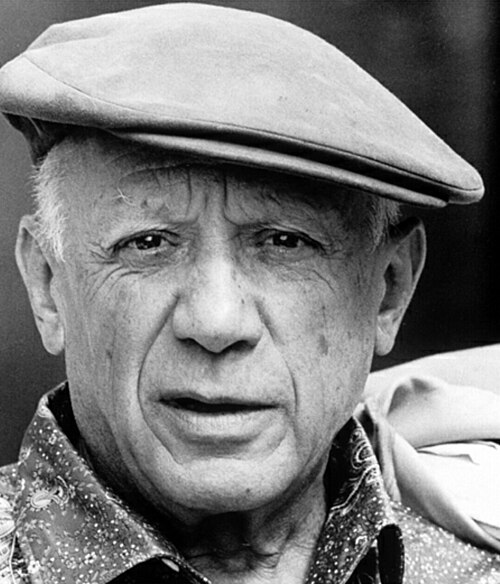
Pablo Picasso Credit: TyreniusPablo Picasso (October 25, 1881 — April 8, 1973) was an artist and sculptor. Picasso was born in Málaga, Spain. This image was taken of him in 1962, eleven years before his death. -
Image 18Gaspar de Guzmán, Count-Duke of Olivares (1587–1645) was a Spanish royal favourite of Philip IV and minister. As prime minister from 1621 to 1643, he over-exerted Spain in foreign affairs and unsuccessfully attempted domestic reform. His policies of committing Spain to recapture the Dutch Republic led to his major involvement in the Thirty Years War. This portrait was completed in 1634, with its composition referring to Olivares' military leadership in the service of King Philip.
-
Image 19Photograph: J.Ligero & I.BarriosA three-month old Spanish ibex (Capra pyrenaica) in Sierra de Gredos, Spain. These ibexes are strong mountain animals characterized by their large and flexible hooves and short legs.
The two sexes of adults form separate social groups; juveniles stay with the female groups from birth until the following birth season, when they leave. Yearling males then join male groups, while females eventually return to their mothers' groups and stay several years. -
Image 20Painting: Marià FortunyThe Spanish Wedding is an oil on panel painting by Marià Fortuny completed over a two-year period ending in 1870. It depicts the signing of a wedding contract in 18th century Spain and was influenced heavily by the works of Francisco Goya, whom the artist admired. It is currently exhibited at the National Art Museum of Catalonia.
-
Image 21Photo credit: David IliffThe Queen Sofia Palace of the Arts (Valencian: Palau de les Arts Reina Sofía) is an opera house located in Valencia, Spain. The last to be completed of the City of Arts and Sciences complex, it was designed by architect Santiago Calatrava. The 14-story structure opened on 8 October 2005.
-
Image 22Photograph credit: Biblioteca Nacional de EspañaAna Santos Aramburo (born 1957) has been the director of the National Library of Spain since February 2013. Having received a degree in geography and history from the University of Zaragoza in Spain, she has spent much of her career working at the Complutense University of Madrid, first at the library of the Faculty of Economics and Business Sciences, and later serving as deputy director of the university library. Later she served as Director of the Historical Library Marquis of Valdecilla, General Director of Libraries and Archives of the City of Madrid, and Director of Cultural Action at the National Library. This photograph of Santos shows her at the headquarters of the National Library of Spain in Madrid.
Did you know...
- ... that some pale stonecrops in Spain closely resemble Israeli specimens, while neighboring plants in Spain can look vastly different?
- ... that Thomas Fenner captained an English warship against the Spanish Armada?
- ... that people of the Zenú culture built canals in the La Mojana wetland area of Colombia long before Spanish arrival?
- ... that the 1983 Spanish floods were the most economically damaging in Spain until the 2024 Spanish floods?
- ... that wealth generated by tourism in Barcelona is claimed to be a reason for increased social inequality, causing activists to protest against overtourism?
- ... that the Kitāb al-ṭabīẖ, a medieval Andalusian cookbook, contains an early version of Jewish challah bread, which traveled with Jews expelled from Spain and likely influenced Ashkenazi cuisine?
 Good article – show another
Good article – show another
-
Image 1

During the Spanish Civil War, most European countries followed a policy of non-intervention to avoid potential escalation or expansion of the war to other states. This policy led to the signing of the Non-Intervention Agreement in August 1936 and the setting up of the Non-Intervention Committee, which first met in September. Primarily arranged by the French and British governments, the committee included the Soviet Union, Fascist Italy, and Nazi Germany. Ultimately, the committee had the support of 27 states. (Full article...) -
Image 2The moonlight Battle off Cape St Vincent, 16 January 1780, Francis Holman
The Battle of Cape St. Vincent (Spanish: Batalla del Cabo de San Vicente) was a naval battle that took place off the southern coast of Portugal on 16 January 1780 during the American Revolutionary War. A British fleet under Admiral Sir George Rodney defeated a Spanish squadron under Don Juan de Lángara. The battle is sometimes referred to as the Moonlight Battle (batalla a la luz de la luna) because it was unusual for naval battles in the Age of Sail to take place at night. It was also the first major naval victory for the British over their European enemies in the war and proved the value of copper-sheathing the hulls of warships. (Full article...) -
Image 3

Barcelona supporters during a match at Camp Nou.
FC Barcelona is a professional multi-sports club based in Barcelona, formed in 1899 by a group of Swiss, Catalan, German and English footballers led by Joan Gamper. It has been part of the Spanish top-flight, La Liga, since the league's inception in 1928, winning it 27 times, along with a record 31 Copa del Rey and five UEFA Champions League victories. (Full article...) -
Image 4Battle of Algesiras by Robert Dodd
The First Battle of Algeciras was fought on 6 July 1801 between a Royal Navy squadron and a smaller French Navy squadron lying at anchor in the Spanish port of Algeciras during the Algeciras campaign of the War of the Second Coalition. The British outnumbered their opponents, but the French position was protected by Spanish gun batteries and the complicated shoals that obscured the entrance to Algeciras Bay. The French squadron, under Counter-Admiral Charles-Alexandre Léon Durand Linois, had stopped at Algeciras en route to the major Spanish naval base at Cadiz, where they were to form a combined French and Spanish fleet for operations against Britain and its allies in the French Revolutionary Wars. The British, under Rear-Admiral Sir James Saumarez, sought to eliminate the French squadron before it could reach Cadiz and form a force powerful enough to overwhelm Saumarez and launch attacks against British forces in the Mediterranean Sea. (Full article...) -
Image 5Outgoing prime minister Mariano Rajoy (right) congratulating incoming prime minister Pedro Sánchez (left) upon losing the no confidence vote on 1 June 2018
A motion of no confidence in the Spanish government of Mariano Rajoy was debated and voted in the Congress of Deputies between 31 May and 1 June 2018. It was brought by Spanish Socialist Workers' Party (PSOE) leader Pedro Sánchez after the governing People's Party (PP) was found to have profited from the illegal kickbacks-for-contracts scheme of the Gürtel case in a court ruling made public the previous day. This was the fourth motion of no confidence since the Spanish transition to democracy and the first one to be successful, as well the second to be submitted against Mariano Rajoy after Unidos Podemos's motion the previous year. Coincidentally, it was held 38 years after the first such vote of no confidence in Spain on 30 May 1980. (Full article...) -
Image 6
Trinidad Arroyo Villaverde (26 May 1872 – 28 September 1959) was a Spanish ophthalmologist. She was the first woman ophthalmologist in Spain and the third to receive a doctorate degree, obtaining her doctorate in 1896. She was a teacher and researcher at the University of Madrid, and she operated an ophthalmology practice with her husband Manuel Márquez. They were forced to flee the country in 1939 due to the Spanish Civil War, and they resumed their practice in Mexico City, where they lived for the rest of their lives. (Full article...) -
Image 7The 2016 Volta a Catalunya was a road cycling stage race that took place in Catalonia, Spain, from 21 to 27 March. It was the fifth race of the 2016 UCI World Tour and the 96th edition of the Volta a Catalunya. (Full article...)
-
Image 8
Queen Anne's War (1702–1713) or the Third Indian War was the second in a series of French and Indian Wars fought in North America involving the colonial empires of Great Britain, France, and Spain; it took place during the reign of Anne, Queen of Great Britain. In the United States, it is often studied as a standalone conflict under this name, although it is also viewed as the American theater of the War of the Spanish Succession. In France, it was known as the Second Intercolonial War. (Full article...) -
Image 9Picture by Johann Jakob Wick illustrating his report about the Battle of Zutphen, published on 12 October 1586
The Battle of Zutphen was fought on 22 September 1586, near the village of Warnsveld and the town of Zutphen, the Netherlands, during the Eighty Years' War. It was fought between the forces of the United Provinces of the Netherlands, aided by the English, against the Spanish. In 1585, England signed the Treaty of Nonsuch with the States-General of the Netherlands and formally entered the war against Spain. Robert Dudley, Earl of Leicester, was appointed as the Governor-General of the Netherlands and sent there in command of an English army to support the Dutch rebels. When Alessandro Farnese, Duke of Parma and commander of the Spanish Army of Flanders, besieged the town of Rheinberg during the Cologne War, Leicester, in turn, besieged the town of Zutphen, in the province of Gelderland and on the eastern bank of the river IJssel. (Full article...) -
Image 10The Legazpi-Sikatuna Blood Compact, or Sandugo (Spanish: Pacto de Sangre), was a blood compact, performed on the island of Bohol in the Philippines, between the Spanish explorer Miguel López de Legazpi and Datu Sikatuna, chieftain of Bohol, on March 16, 1565, to seal their friendship following tribal tradition. This is considered the first treaty of friendship between the Spaniards and Filipinos. Sandugo is a Visayan word meaning "one blood". (Full article...)
-
Image 11
The Battle of Ollantaytambo (Spanish: Batalla de Ollantaytambo, IPA: [baˈtaʎa ðe oʎantajˈtambo]) took place in January 1537, between the forces of Inca emperor Manco Inca and a Spanish expedition led by Hernando Pizarro during the Spanish conquest of Peru. A former ally of the Spaniards, Manco Inca rebelled in May 1536, and besieged a Spanish garrison in the city of Cusco. To end the stand-off, the besieged mounted a raid against the emperor's headquarters in the town of Ollantaytambo. The expedition, commanded by Hernando Pizarro, included 100 Spaniards and some 30,000 Indian auxiliaries against an Inca army of more than 20,000. (Full article...) -
Image 12Illustration of the bombing in Le Petit Journal
The Liceu bombing was a terrorist attack by the Spanish anarchist Santiago Salvador, who killed 20 to 30 people at Barcelona's Grand Lyceum Theatre on 7 November 1893. The bombing was in response to the execution of Paulí Pallàs, who had himself attempted to assassinate the Captain General of Catalonia, Arsenio Martínez Campos. (Full article...) -
Image 13

The route of the 2015 Vuelta a España
The 2015 Vuelta a España was a three-week Grand Tour cycling race that took place principally in Spain between 22 August and 13 September 2015; two stages also took place partly or wholly in Andorra. The final ten stages took the race from the mountains of Andorra to the conclusion of the Vuelta in Madrid. After the first eleven stages, Fabio Aru (Astana) held the race lead, around half a minute ahead of Joaquim Rodríguez (Team Katusha) and Tom Dumoulin (Team Giant–Alpecin). (Full article...) -
Image 14

The 2016 Spanish Grand Prix (formally known as the Formula 1 Gran Premio de España Pirelli 2016) was a Formula One motor race held on 15 May 2016 at the Circuit de Barcelona-Catalunya in Montmeló, Spain. The race was the fifth round of the 2016 FIA Formula One World Championship, and marked the forty-sixth running of the Spanish Grand Prix as a round of the Formula One World Championship. It was the twenty-sixth time that the race has been held at the circuit. (Full article...) -
Image 15

Hypericum grandifolium, the large-leaved St John's wort, is a species of flowering plant in the family Hypericaceae. The plant is a bushy shrub that can grow to almost 2 meters tall. It has large leaves, golden yellow petals, and seed capsules that split open. H. grandifolium is native to the Canary Islands and Madeira in Macaronesia, but has become invasive in other regions, including California, after escaping from cultivation as an ornamental plant. It is parasitized by wasps and fungi, and is capable of reproducing through its rhizomes. (Full article...) -
Image 16Near the Saaler Bodden, Germany
The grey heron (Ardea cinerea) is a long-legged wading bird of the heron family, Ardeidae, native throughout temperate Europe and Asia, and also parts of Africa. It is resident in much of its range, but some populations from the more northern parts migrate southwards in autumn. A bird of wetland areas, it can be seen around lakes, rivers, ponds, marshes and on the sea coast. It feeds mostly on aquatic creatures which it catches after standing stationary beside or in the water, or stalking its prey through the shallows. (Full article...) -
Image 17
Badajoz is the capital of the Province of Badajoz in the autonomous community of Extremadura, Spain. It is situated close to the Portuguese border, on the left bank of the river Guadiana. The population in 2011 was 151,565. (Full article...) -
Image 18
The Punic Wars were a series of wars between 264 and 146 BC fought between the Roman Republic and the Carthaginian Empire. Three wars took place, involving a total of forty-three years of warfare on both land and sea across the western Mediterranean region. The Punic Wars are also considered to include the four-year-long revolt against Carthage which started in 241 BC. Each war involved immense material and human losses on both sides. (Full article...) -
Image 19

Portrait by Vicente López y Portaña, 1815
Richard Worsam Meade (June 23, 1778 – June 25, 1828) was an American merchant and art collector, and the father of Civil War General George Gordon Meade. After growing up in his father George Meade's shipping business, he became successful in his own right in the American–Spanish trade. Meade lived in Cadiz, Spain, from 1803 to 1820, and was the U.S. naval agent there. He became quite wealthy and was one of the first American collectors of European art. (Full article...) -
Image 20Real Madrid Club de Fútbol (Spanish pronunciation: [reˈal maˈðɾið ˈkluβ ðe ˈfuðβol] ⓘ), commonly referred to as Real Madrid, is a Spanish professional football club based in Madrid. The club competes in La Liga, the top tier of Spanish football. (Full article...)
-
Image 21Mariano Rajoy being congratulated by PSOE spokesperson Antonio Hernando after his successful investiture as prime minister on 29 October 2016.
Attempts to form a government in Spain followed the inconclusive Spanish general election of 20 December 2015, which failed to deliver an overall majority for any political party. As a result, the previous People's Party (PP) cabinet headed by Mariano Rajoy was forced to remain in a caretaker capacity for 314 days until the next government could be sworn in. (Full article...) -
Image 22
Juan Manuel López Mella (12 April 1965 – 10 May 1995) was a Spanish professional motorcycle racer at Grand Prix and Superbike levels. After coming second in the national championships in 1985, he entered international competitions for the first time in 1987. He was the first person from Galicia to enter the competition. He came third in the 1991 Spanish Superbike race at Jarama, the first person from Spain to gain a podium position in the competition, and was named Spanish Superbike champion in both 1991 and 1992, becoming the highest placed private rider overall in 1993. In 1995, he started riding in the Thunderbike tournament but was killed in a road accident early in the season. Lugo, his city of birth, has named a park that teaches road safety in his honour and hosts a museum in his memory. (Full article...) -
Image 23The 1977 Atocha massacre was an attack by right-wing extremists in the center of Madrid on 24 January 1977, which saw the assassination of five labor activists from the Communist Party of Spain (PCE) and the workers' federation Comisiones Obreras (CC.OO). The act occurred within the wider context of far-right reaction to Spain's transition to constitutional democracy following the death of dictator Francisco Franco. Intended to provoke a violent left-wing response that would provide legitimacy for a subsequent right-wing counter coup d'état, the massacre had an immediate opposite effect, generating mass popular revulsion of the far-right and accelerating the legalization of the long-banned Communist Party. (Full article...)
-
Image 24
The 2015 Spanish Grand Prix, formally titled the Formula 1 Gran Premio de España Pirelli 2015, was a Formula One motor race held on 10 May 2015 at the Circuit de Barcelona-Catalunya in Montmeló, Spain. The race was the fifth round of the 2015 season and marked the forty-fifth running of the Spanish Grand Prix as a round of the Formula One World Championship and the twenty-fifth running at Catalunya. Mercedes driver Nico Rosberg took his first win of the season, his first in Spain and the ninth of his career. His team-mate Lewis Hamilton finished second after a bad start, followed by Sebastian Vettel in third. (Full article...) -
Image 25
The Spanish coup of July 1936 was a military uprising that was intended to overthrow the Spanish Second Republic but precipitated the Spanish Civil War; Nationalists fought against Republicans for control of Spain. The coup was organized for 18 July 1936, although it started the previous day in Spanish Morocco. Instead of resulting in a prompt transfer of power, the coup split control of the Spanish military and territory roughly in half. The resulting civil war ultimately led to the establishment of a nationalist regime under Francisco Franco, who became ruler of Spain as caudillo. (Full article...)
General images
-
Image 1Detail of the votive crown of Recceswinth from the Treasure of Guarrazar, (Toledo-Spain) hanging in Madrid. The hanging letters spell [R]ECCESVINTHVS REX OFFERET [King R. offers this]. (from History of Spain)
-
Image 4People's militias attacking on a Rebel position in Somosierra in the early stages of the war. (from History of Spain)
-
Image 6The promulgation of the Constitution of 1812, oil painting by Salvador Viniegra. (from History of Spain)
-
Image 7Visigothic Hispania and its regional divisions in 700, prior to the Muslim conquest (from History of Spain)
-
Image 8The Christian kingdoms of Hispania and the Islamic Almohad empire c. 1210
-
Image 9Plaza Mayor with the Casa de la Panadería to the left (from Spanish Golden Age)
-
Image 11The title page of the Gramática de la lengua castellana (1492), the first grammar of a modern European language to be published. (from History of Spain)
-
Image 12In ictu oculi ("In the blink of an eye"), a vanitas by Juan de Valdés Leal (from Spanish Golden Age)
-
Image 14Cabeza de Luis Buñuel, sculptor's work by Iñaki, in the center Buñuel Calanda. (from Culture of Spain)
-
Image 16The Port of Seville in the late 16th century. Seville became one of the most populous and cosmopolitan European cities after the expeditions to the New World. (from History of Spain)
-
Image 18Map of territories that were once part of the Spanish Empire (from History of Spain)
-
Image 20Las Meninas (1656, English: The Maids of Honour) by Diego Velázquez (from Spanish Golden Age)
-
Image 21Visigothic church, San Pedro de la Nave. Zamora. Spain (from History of Spain)
-
Image 23The explosion of the USS Maine launched the Spanish–American War in April 1898 (from History of Spain)
-
Image 29The Second of May 1808 was the beginning of the popular Spanish resistance against Napoleon. (from History of Spain)
-
Image 30Felipe González signing the treaty of accession to the European Economic Community on 12 June 1985. (from History of Spain)
-
Image 31Proclamation of the Spanish Republic in Madrid (from History of Spain)
-
Image 33Charles I of Spain (better known in the English-speaking world as the Holy Roman Emperor Charles V) was the most powerful European monarch of his day. (from History of Spain)
-
Image 34Illustration depicting the (now lost) Luzaga's Bronze, an example of the Celtiberian script. (from History of Spain)
-
Image 36The pro-independence forces delivered a crushing defeat to the royalists and secured the independence of Peru in the 1824 battle of Ayacucho. (from History of Spain)
-
Image 401894 satirical cartoon depicting the tacit accord for seamless government change (turnismo) between the leaders of two dynastic parties (Sagasta and Cánovas del Castillo), with the country being lied in an allegorical fashion. (from History of Spain)
-
Image 41Wedding portrait of the Catholic Monarchs (from History of Spain)
-
Image 42The Conquest of Tenochtitlán (from History of Spain)
-
Image 43Members of the provisional government after the 1868 Glorious Revolution, by Jean Laurent. (from History of Spain)
-
Image 45Visigothic King Roderic haranguing his troops before the Battle of Guadalete (from History of Spain)
-
Image 48Recognition of the Duke of Anjou as King of Spain, under the name of Philip V, November 16, 1700 (from History of Spain)
-
Image 49Two women and a man during the siege of the Alcázar (from History of Spain)
-
Image 50The successful 1925 Alhucemas landing turned the luck in the Rif War towards Spain's favour. (from History of Spain)
-
Image 51Episode of the 1854 Spanish Revolution in the Puerta del Sol, by Eugenio Lucas Velázquez. (from History of Spain)
-
Image 54Francisco Franco and his appointed successor Prince Juan Carlos de Borbón. (from History of Spain)
-
Image 56El paseo de las Delicias, a 1784–1785 painting by Ramón Bayeu depicting a meeting of members of the aristocracy in the aforementioned location. (from History of Spain)
-
Image 57Ethnology of the Iberian Peninsula c. 200 BC (from History of Spain)
-
Image 59Panoramic view of the lower level patio of the Palace (from Spanish Golden Age)
-
Image 62The Iberian Peninsula in the 3rd century BC (from History of Spain)
-
Image 64Celebrations of the proclamation of the 2nd Republic in Barcelona. (from History of Spain)
-
Image 65The greatest extent of the Visigothic Kingdom of Toulouse, c. 500, showing Territory lost after Vouillé in light orange (from History of Spain)
-
Image 66Christopher Columbus leads expedition to the New World, 1492, sponsored by Spanish crown (from History of Spain)
-
Image 67Louis XIV of France and Philip IV of Spain at the Meeting on the Isle of Pheasants in June 1660, part of the process to put an end to the Franco-Spanish War (1635–59). (from History of Spain)
-
Image 70Execution of Torrijos and his men in 1831. Ferdinand VII took repressive measures against the liberal forces in his country. (from History of Spain)
In the news
- 14 April 2025 –
- The Spanish Civil Guard arrests two Russian citizens in Manacor, Mallorca, for alleged breeding and sale of exotic cats, and recover a caracal, two servals, and sixteen felid hybrids. (DW)
- 10 April 2025 – 2025 Hudson River helicopter crash
- A Bell 206 sightseeing helicopter crashes into the Hudson River off Lower Manhattan, New York, United States, killing Siemens Spain CEO Agustín Escobar, his family of four, and the pilot. (AP) (ABC News)
No recent news
Spain topics
Categories
WikiProjects
- Main project
- Related projects
WikiProject Basque • WikiProject Catalan-speaking Countries • WikiProject Galicia • Spanish Translation of the Week
Things you can do

- Add {{WikiProject Spain}} to article talk pages which have some relation to Spain
- Help write new Spain-related articles and improve and expand existent ones
- Assess: unassessed Spain-related articles
- Suggest: selected articles, biographies, pictures, did you knows? and quotes for this Portal
Related portals
Associated Wikimedia
The following Wikimedia Foundation sister projects provide more on this subject:
-
Commons
Free media repository -
Wikibooks
Free textbooks and manuals -
Wikidata
Free knowledge base -
Wikinews
Free-content news -
Wikiquote
Collection of quotations -
Wikisource
Free-content library -
Wikiversity
Free learning tools -
Wikivoyage
Free travel guide -
Wiktionary
Dictionary and thesaurus
- Pages using Template:Post-nominals with customized linking
- Pages with Spanish IPA
- Pages using the Phonos extension
- Pages including recorded pronunciations
- Portals with triaged subpages from June 2018
- All portals with triaged subpages
- Portals with no named maintainer
- Automated article-slideshow portals with 41–50 articles in article list
- Random portal component with 6–10 available subpages
- Automated article-slideshow portals with 101–200 articles in article list



















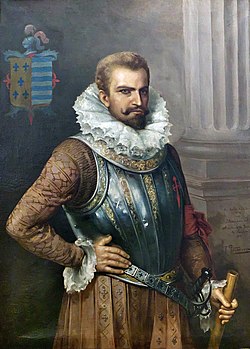




















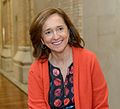

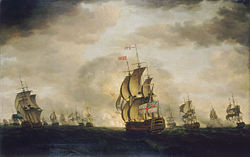


















![Image 1Detail of the votive crown of Recceswinth from the Treasure of Guarrazar, (Toledo-Spain) hanging in Madrid. The hanging letters spell [R]ECCESVINTHVS REX OFFERET [King R. offers this]. (from History of Spain)](http://upload.wikimedia.org/wikipedia/commons/thumb/f/f2/Corona_de_%2829049230050%29.jpg/60px-Corona_de_%2829049230050%29.jpg)


















